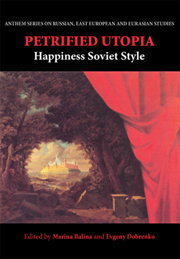Book contents
- Frontmatter
- Contents
- List of Illustrations
- Acknowledgments
- List of Contributors
- Introduction
- Petrified Utopia
- Part One Utopics
- Part Two Realities
- Part Three Locations
- 9 The ‘New Moscow’ and the New ‘Happiness’: Architecture as a Nodal Point in the Stalinist System of Value
- 10 Andrei Platonov's Happy Moscow: Tolstoi, Stalin and the Soviet Self
- 11 ‘But Where is Your Happiness, Alevtina Ivanovna?’: New Debates about Happiness in the Soviet Films of 1956
- 12 Easy on the Heart; or ‘Strength Through Joy’
- Notes
- Index
10 - Andrei Platonov's Happy Moscow: Tolstoi, Stalin and the Soviet Self
from Part Three - Locations
Published online by Cambridge University Press: 05 March 2012
- Frontmatter
- Contents
- List of Illustrations
- Acknowledgments
- List of Contributors
- Introduction
- Petrified Utopia
- Part One Utopics
- Part Two Realities
- Part Three Locations
- 9 The ‘New Moscow’ and the New ‘Happiness’: Architecture as a Nodal Point in the Stalinist System of Value
- 10 Andrei Platonov's Happy Moscow: Tolstoi, Stalin and the Soviet Self
- 11 ‘But Where is Your Happiness, Alevtina Ivanovna?’: New Debates about Happiness in the Soviet Films of 1956
- 12 Easy on the Heart; or ‘Strength Through Joy’
- Notes
- Index
Summary
Andrei Platonov's novel Happy Moscow (Schastlivaia Moskva) was long in the writing: from 1932 his notebooks were to be filled with fitful ideas of plot and characterisation for a work that was to obsess him for several more years, and in 1933, he finished the first six chapters. What we now know as Happy Moscow may, in fact, have been intended as part of a longer work, Journey from Leningrad to Moscow in 1937 (Puteshestvie iz Leningrada v Moskvu v 1937 godu), yet despite contracts with leading publishers, he never fulfilled his plans; in the end, only the second chapter of Happy Moscow was published, in the form of a short story. Whether the novel's ambitious conception was ultimately beyond realisation (unlikely from the author of Chevengur (Chevengur)), whether other projects (such as Takyr (Takyr) and Soul (Dzhan), the works relating to Platonov's visits to Turkmenistan in 1934 and 1935) took priority, or whether aesthetic considerations rendered the work obsolete and even dangerous (the stories collected in the 1937 volume The River Potudan (Reka Potudan') are altogether more deferential to Socialist Realism), by the time Platonov's son was arrested in 1938, work on the novel had been resolutely abandoned. Eventually published for the first time only in 1991, Happy Moscow has since become one of Platonov's most commented-upon works.
- Type
- Chapter
- Information
- Petrified UtopiaHappiness Soviet Style, pp. 201 - 216Publisher: Anthem PressPrint publication year: 2009



